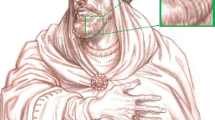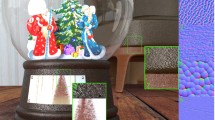Abstract
Although realistic textile rendering has been widely used in virtual garment and try-on systems, a robust method to simulate textile with a realistic appearance and high fidelity is yet to be established. We propose to use a novel hybrid geometric- and image-based rendering (GIBR) method to achieve photo realistic representation of textile products. The image-based technique, with its radiance synthesis algorithm, enables us to recover the reflectance properties of textile in an environment photo, and thus can render the appearance of textile material. The geometry-based technique, with its traditional illumination model of assigning illumination parameters extracted from the original scene (such as radiance and chroma dispatch), makes it possible to interactively manipulate 3D virtual objects in the “real” environment. Our realistic textile rendering method has advantages over the traditional ones in its easiness to implement and its wide range of applications.
Similar content being viewed by others
References
Oren M, Nayar S K. Generalization of lambert’s reflectance model. In: SIGGRAPH’94, Orlando, 1994. 239–246
Matusik W, Pfister H, Brand M, et al. Efficient isotropic BRDF measurement. In: Eurographics Symp Rendering, Leuven Belgium, 2003. 241–247
Ward G J. Measuring and modeling anisotropic reflection. ACM Comput Graph, 1992, 26(2): 265–272
Ashikhmin M, Premoze S, Shirley P. A microfacet-based BRDF generator. In: SIGGRAPH’00, New Orleans, 2000. 65–74
Matusik W, Pfister H, Brand M, et al. A data-driven reflectance model. In: SIGGRAPH’03, San Diego, 2003. 759–769
Ngan A, Durand F, Matusik W. Experimental analysis of BRDF models. In: Eurographics Symp. Rendering, Konstanz, Germany, 2005. 117–226
Nayar S K, Belhumeur P N, Boult T E. Lighting sensitive display. Proc ACM SIGGRAPH, Technical Sketch, 2004, 23(4): 963–979
Masselus V, Dutre P, Anrys F. The free-form light stage. In: 13th Eurographics Workshop on Rendering, Pisa Italy, 2002. 247–256
Goesele M, Granier X, Heidrich W, et al. Accurate light source acquisition and rendering. ACM Trans Graph, 2003, 22(3): 621–630
Yu J J, Yang X B, Xiao S J. Physical light acquisition based interactive relighting. Yantai, Shandong, August 2007
Horn B, Schunch B. Determining optical flow. Artif Intell, 1981, 17(1): 185–203
Yeasin M. Optical flow in log-mapped image plane. IEEE Trans Patt Analy Mach Intell, 2002, 24(1): 125–131
Cook R L, Torrance K E. A reflection model for computer graphics. Comput Graph, 1981, 15(3): 307–316
Shafer S. Using color to separatere reflection components. Color Research Appl, 1985, 10(4): 210–218
Lee H C, Breneman E J, Schulte C. Modeling light reflection for computer color vision. IEEE Trans Patt Analy Mach Intell, 1990, 12(4): 402–409
Tominaga S. Dichromatic reflection models for rendering object surfaces. J Imag Sci Tech, 1996, 40(6): 549–555
Zhang M M, Pan Z G, Ren L F, et al. Image-based virtual exhibit and its extension to 3D. Acta Automat Sin, 2007, 4(1): 18–24
Wang P, Zhang M M, John X, et al. An image-based texture mapping technique for apparel products exhibition and interior design. DISPLAYS, 2003, 24(4–5): 179–186
Pan Z G, Wang P, John X, et al. An illumination distribution preserved color substitution algorithm based on dichromatic reflection model. DISPLAYS, 2003, 26(3): 121–127
Tominaga S, Tanaka N. Estimating reflection parameters from a single color image. IEEE Comput Graph Appl, 2000, 20(5): 58–66
Author information
Authors and Affiliations
Corresponding author
Additional information
Supported by the National Natural Science Foundation of China (Grant No. 60533080), and Intelligent Interaction and Navigation in VE (Grant No. 08dz0580208)
Rights and permissions
About this article
Cite this article
Zhang, M., Pan, Z., Shi, J. et al. A hybrid rendering algorithm for textile objects. Sci. China Ser. F-Inf. Sci. 52, 490–499 (2009). https://doi.org/10.1007/s11432-009-0067-z
Received:
Accepted:
Published:
Issue Date:
DOI: https://doi.org/10.1007/s11432-009-0067-z




